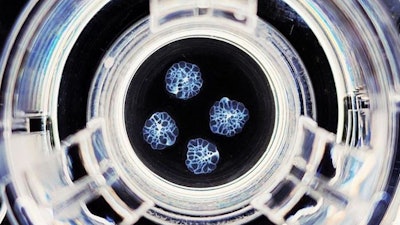
Scientists at Nanyang Technological University, Singapore (NTU Singapore) have successfully grown ‘mini kidneys’ in the lab and grafted them into live mice, revealing new insights into the metabolic defects and a potential therapy for polycystic kidney disease.
‘Mini kidneys,’ or kidney organoids, are kidney-like structures grown in the lab using stem cells. In the study led by NTU’s Lee Kong Chian School of Medicine (LKCMedicine), researchers grew the organoids using skin cells derived from patients with polycystic kidney disease (PKD), a prevalent form of genetic condition that affects 1 in 1000 individuals across all ethnicities.
People with PKD often progress to end-stage kidney disease between their 50s and 60s, with the standard treatment options available being dialysis or a kidney transplant. However, dialysis significantly compromises a patient’s quality of life, while a transplanted kidney can be challenging to acquire. One other option is the Food and Drug Administration (FDA) approved drug Tolvaptan, which is very costly and has severe side effects on the liver.
To address the need for more effective treatment for PKD patients, the NTU research team sought to better understand the disease by engrafting their newly developed mini kidneys into mice.
Previous studies were conducted on mini kidneys grown in a dish, which could only partly mimic the kidney structure and function. The NTU scientists engrafted the mini kidneys into live mice to comprehensively replicate the pathological features of kidney disease, including blood flow, fluid movement (tubular fluid) and cellular communication with other organs.
Lead investigator Assistant Professor Xia Yun at LKCMedicine said, “Engrafting the kidney organoid in mice provided us with a physiologically sophisticated approach to studying polycystic kidney disease as we were able to successfully emulate critical disease characteristics similar to those observed in human kidney patients.”
Critical disease characteristics included abnormalities like the spontaneous formation of cysts in the kidneys and the subsequent damage to its tiny tubes.
In their study, reported in the scientific journal Cell Stem Cell, the NTU research team said that they believed their engrafted mini kidneys were high quality because cysts sustained without extra stress stimulation or chemicals, even after they were removed from the live mice for further investigations in a dish. In contrast, previous kidney organoids grown in a dish cannot form cysts without stress stimulation.
Co-investigator Assistant Professor Foo Jia Nee at LKCMedicine said, “The similarity between the disease manifestation observed in our engrafted mini kidney model and the real-life experiences of polycystic kidney disease patients suggest that growing kidney organoids and engrafting them into live mice could be beneficial in studying the disease and a useful tool to test new treatments.”
Metabolic defects in polycystic kidney disease
Scientists have long known that abnormalities in a structure on kidney cells, or the primary cilium, cause cysts to form in kidneys. However, tests to understand the regulatory mechanism and relationship between the primary cilium and cell metabolism (autophagy) in live mice with PKD, have not been possible until now.
By studying the development of PKD in live mice and testing cellular pathways, researchers found evidence that boosting autophagy could reduce the severity of cysts in the mini kidney.
After establishing that boosting autophagy could reduce cysts, the NTU scientists shortlisted 22 drugs known for their effects on cell metabolism and tested them in the lab. Results showed that minoxidil, a clinical drug widely used to cure hypertension and hair loss, effectively reduced cyst formation in the novel mouse model.
Asst Prof Xia Yun said, “Our study has demonstrated how cysts in polycystic diseased kidneys can be reduced by boosting autophagy, suggesting that this could be a promising treatment for PKD. Moreover, the proven clinical safety of minoxidil may allow it to be quickly re-purposed to treat PKD patients in clinic. However, more research will be needed to establish this potential.”
Commenting as an independent expert, Associate Professor Ng Kar Hui, Senior Consultant, Division of Paediatric Nephrology, Dialysis and Renal Transplantation, Department of Pediatrics, Khoo Teck Puat – National University Children's Medical Institute, National University Hospital, said, “Polycystic kidney disease is one of the biggest causes of chronic kidney diseases among adults. An effective treatment may potentially ameliorate the rising numbers of people with kidney failure in Singapore. The establishment of such models in live organisms brings us one step closer to finding more treatment options.
In future studies, the NTU team will test the efficacy of minoxidil and adapt the mini kidney models to investigate other burgeoning kidney diseases without a strong genetic underpinning, such as diabetic kidney disease.






















